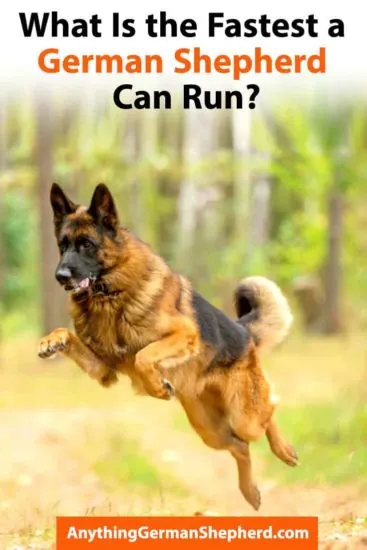What Is the Fastest a German Shepherd Can Run?
Which breeds are the athletes of the dog world? You might think about the bodybuilder types like the Staffordshire Bull Terrier or Cane Corso, or even canine dancers like the Poodle.
But what most likely first comes to mind are the all-around jocks who are up for any task or challenge like the German Shepherd or Doberman. Then there are the pure runners like the Greyhound and Whippet.
Unless you think in terms of the ability to track down a suspect, you may not consider running a defining trait of the German Shepherd Dog. Nevertheless, have you ever wondered how fast a German Shepherd can run?
You may be surprised to learn they are among the fastest canines in the world! German Shepherds can run at speeds of about 30 to 32 miles per hour.
We compare the GSD’s running speed and style with other breeds, as well as various animals known for their world-class quickness. We will also go over what affects how fast a German Shepherd can run, and in what activities its speed is most useful.
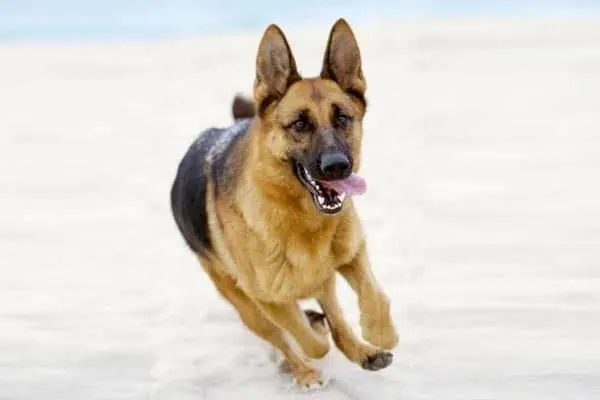
How Fast Can a German Shepherd Run? Gaits Affect Speed
When someone asks how fast the quickest human can go, everyone knows they’re referring to a flat out sprint. Four-legged animals, however, generally have four main gaits, or paces.
When referring to how fast a dog or horse can run, we’re talking about the animal’s speed at a gallop.
- Walk – A four-beat gait whereby the feet move one after the other and at least one foot is always on the ground. Three feet have a brief moment where they land at the same time.
- Trot – The trot involves the simultaneous movement of the diagonal pairs of legs. A moment of suspension follows each striking of the ground, allowing the animal to switch diagonals with each stride. Shepherds can probably trot 17 to 18 miles per hour.
- Canter – The cantering dog is running but not as fast as a full-speed gallop. A canter is a three-beat gait whereby the dog leads with either the right or left front foot. He then lands with two diagonals followed by one foot and then a moment of suspension. For example, a left canter would be left fore, right fore and left hind simultaneously, right hind, then suspension. Horses canter much more often than dogs.
- Gallop – A gallop is a full out run where you would measure an animal’s top speed. Some mammals, like the sloth, do not gallop. The gallop, similarly to the walk, sees the feet hitting the ground in sequence one by one, but it is much faster and features one or two periods of suspension.
Pacing
The AKC and other clubs that provide guidelines for the show ring do not accept pacing in very many dog breeds.
Pacing is much like the trot, except the pairs of legs on the same side of the body move in unison instead of the diagonals. It is still a two-beat gait with a moment of suspension.
To get a clearer picture of pacing, imagine how a camel or a Standardbred racehorse moves. In the show, ring pacing is acceptable in the Old English Sheepdog or Neapolitan Mastiff as two examples.
Galloping
There are two forms of galloping, and some animals engage in one type or the other exclusively. Others flip between the two depending on how fast they are moving.
Galloping is always a four-beat gait. The following sequences can vary depending on if the animal leads with the right or left leg. Both the following footfalls are leading with the right hind.
- Transverse gallop – A rocking gait, it has a sequence of right hind, left hind, right fore, left fore, followed by suspension whereby the legs are gathered under the body. At extreme speeds, there may be a second suspension just before the right fore hits the ground.
- Rotationary gallop – A leaping gallop that enables double suspension for each stride. The right hind, left hind hit in sequence followed by suspension with the legs fully extended; then, the left fore and right fore hit in sequence followed by suspension with the legs gathered under the body.
If German Shepherds are Fast, Why Don’t They Race?
As versatile as German Shepherds are, it may seem odd that they do not race – they are certainly competitive and motivated enough. German Shepherds have good speed and exceptional stamina, as well as high prey drives which should only enhance their racing abilities.
The gallop is not the GSD’s best gait.
Although German Shepherds are fleet of foot and among the quicker dogs, they were not originally intended to be runners.
The German Shepherd is a working dog whose most efficient gait is the trot. German Shepherd show dogs exaggerate the beauty and flashiness of the breed’s trot, but the primary goal was overall utility.
Herding Shepherds were perimeter dogs who established boundaries for sheep where there were no fences. Rather than drive or gather sheep, they monitored the perimeter of a herd to prevent strays.
They also kept the entire herd from venturing onto forbidden crops or dangerous roads. A shepherd’s job involved sustained trotting most of the day with periodic bursts of short sprints.
How does the double-suspended gallop fit in?
One reason German Shepherd would never be able to race as effectively as Greyhounds is because of the double-suspended gallop.
All dogs perform a double-suspended gallop at full speed. This refers to the way the dog’s body is suspended during both phases of gathering his limbs underneath himself, and the second phase of extending the front legs well forward and rear limbs all the way to the back.
This video shows a working type of black GSD running at speed. Notice the two suspended periods over the duration of each stride.
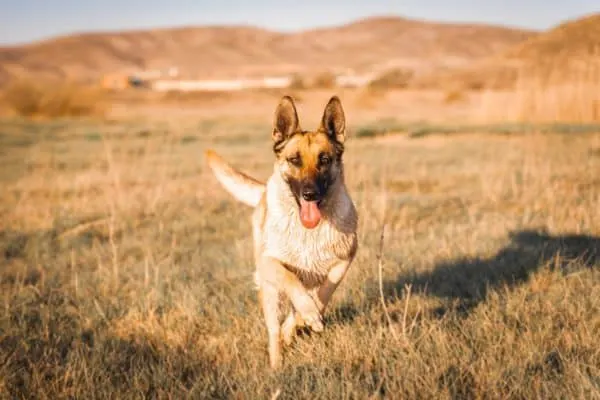
Sighthounds like Greyhounds and Salukis have remarkable spinal flexibility compared to other breeds. This makes their double-suspended gallop dramatically more effective, and enables these dogs to reach phenomenal speeds.
For example, a Whippet can run 35 miles per hour, a Scottish Deerhound 40 miles per hour, and a Greyhound a blistering 45 miles per hour. Retrievers, on the other hand, only run 20 to 25 miles per hour.
The flexibility of the spine enhances the double-suspended gallop because the back is able to contract and extend like a coil.
Comparatively, a horse has a rigid spine and usually a single-suspension gallop. They’re significantly bigger than dogs, but interestingly enough, racehorses only reach speeds of 44 miles per hour.
Although the fastest recorded equine clocked in at 55 miles per hour, dogs are not as far behind as you might expect.
The fastest recorded Greyhound ran about 42 miles per hour, but there is an unofficial clocking of an Australian dog who ran a little over 50 miles per hour.
Other animals that utilize the double-suspended gallop are the Cheetah and Gazelle. They run 70 miles per hour and 60 miles per hour, respectively.
However, many animals run with double suspension, including all cats. Lions have short bursts of 50 miles per hour and a domesticated cat can reach 25 to 30 miles per hour. Pronghorn antelopes run 60 miles per hour.
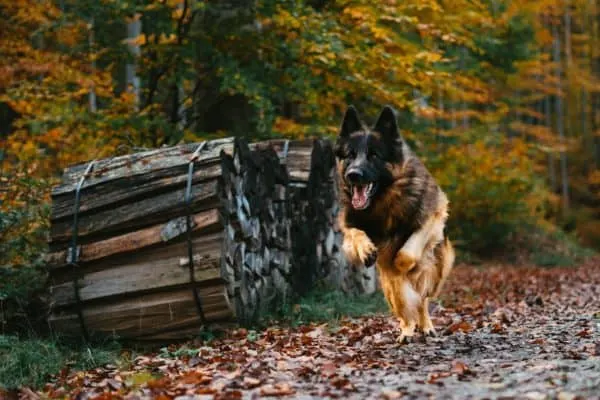
Physical Attributes That Will Help the German Shepherd Run Faster
While German Shepherd Dogs cannot replicate racing Greyhounds’ spinal flexibility, they do possess numerous other qualities that help increase overall speed.
- Relatively long legs
- Lean Bodies
- Muscular strength
- Aerodynamic shape to the head – Moderate in Shepherds, with a slight dome to the forehead but long narrow muzzle.
- Flexible spine
- Ideal angulation of shoulders and hindquarters
We can assume that the more a German Shepherd deviates from Max von Stephanitz’s working dog standard, the slower it will likely be.
A relatively long body allows the legs to have more room to come underneath, giving more propelling force. However, if a dog is too long, this can compromise balance and speed as a result.
As noted above, one of the major determining factors in speed is the flexibility of the spine. German Shepherds do in fact have relatively supple spines, making them faster than Retrievers, but nowhere near Sighthound speed.
In fact, their ranking among the fastest dogs is directly correlated with the flexibility of the spine. However, modern breeding standards and practices are constantly changing the GSD’s physical traits.
Modern breeding practices
Show line breeders’ emphasis on rear leg angles often results in German Shepherds that have over angulated hindquarters in relation to the shoulders.
While the breed standard calls for an angle of 45 degrees where the shoulder connects to the humerus, others believe the angle should be closer to 30 degrees.
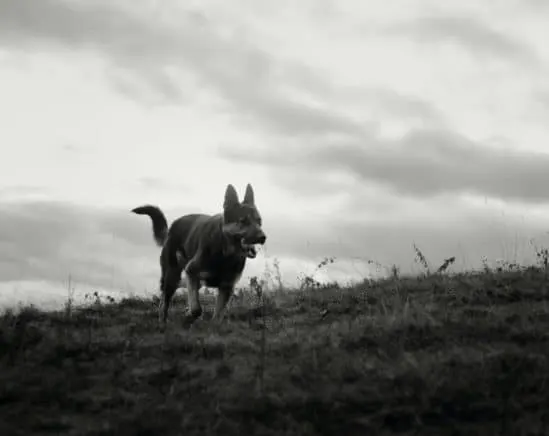
The resulting show Shepherds often have a drastically sloping topline and a vertical croup.
Although her croup resembles the exaggeration you see in a Borzoi’s hips, when combined with the over angulated knees and hocks, it becomes even harder to effectively perform the trot and gallop.
Show Shepherds look brilliant in the show ring but can display balance issues, and it is debatable whether these dogs would be able to sustain the trot the way a working GSD can.
Finally, oversized dogs won’t be able to run as fast as dogs more representative of their breed. Dogs run at average speeds of 15 to 20 miles per hour, but St Bernards and other massive breeds will actually run much slower than these average speeds.
Just as you would imagine, the healthiest dogs are usually the fastest dogs, which is just one of the many reasons why regular exercise and a proper diet are so important for your German Shepherd.
Working German Shepherds reach physical and mental maturity at about three years of age, and will probably remain in their prime until six years of age. Sadly, it is during the later years that health issues typically arise.
Orthopedic disorders like hip or elbow dysplasia prove devastating to movement and speed because of inhibited mobility, not to mention the discomfort and pain the GSD is experiencing.
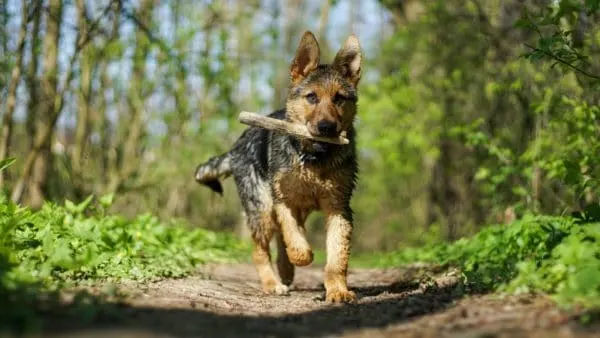
What is a German Shepherd Dog’s Speed Good For?
As German Shepherds remain one of the most versatile dogs for a variety of activities, their speed is invaluable in countless domains.
Herding Trials
Training facilities worldwide have opened their doors to casual dog owners to engage in a time-honored activity with their dogs.
Tending, the true herding ability of German Shepherds may be more difficult to find than the A trials favored by Border Collies.
However, if you have an interest in herding, you can train your Shepherd in trial types. Trials will require your dog to be fit, and exhibit agility and bursts of speed at the appropriate times.
This video shows a GSD herding and how he performs most herding work at a trot.
Police Work
Although many German Shepherds on the police force do not need much speed when completing search and rescue operations, or sniffing for bombs or narcotics, others still engage in the pursuit of suspects.
Given that the fastest human can run over 23 miles per hour for at least the length of a football field, the Shepherd’s superior speed is essential in tracking down criminals.
Military
Some working Shepherds in Europe during the Cold War patrolled the borders of entire countries. Their purpose was to chase down would-be refugees.
Czech and East German working Shepherds still possess the tireless energy and smaller leaner build ideal for running fast.
Agility
Have you ever noticed you never see a competitive agility dog perform the exercise at a walk? You may not think of agility as a speed port, but it is a timed trial.
Judges penalize dogs who do not perform the agility course within a set time, similarly to showjumping horses. German Shepherds excel at agility because of their speed and nimbleness, despite their size compared to other competitors.
Fly Ball
Fly ball is a type of relay where dogs carry a ball while running over a set of obstacles, and speed is of the essence. People often think of Jack Russell Terriers and Border Collies for a fly ball, but Shepherds can add depth to a team with their impressive power and longer legs.
